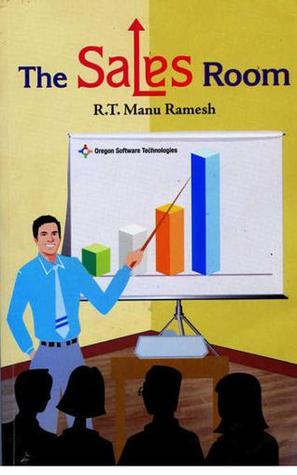About the book:
 Rajesh Iyer, a young, ambitious salesperson, returns to ñThe Sales Roomî of Oregon Software Technologies after an aborted attempt at getting into a business school in the US, only to notice the metamorphosis of the software start-up which he had earlier been an integral part of. What used to be a rat-infested hole in the midst of a vegetable market is now a swanky, state of the art facility owned by an upcoming Bollywood star. The enthusiastic and compact team firing on all cylinders is replaced by a sclerotic and bureaucratic set up. Sales review meetings, once rife with passionate discussions, are now replete with profanities. The ill tempered angel investor's scream can be heard all the way from his villa in New York.Rajesh, now shunted into an innocuous role finds every effort made to alleviate the condition of the demoralized sales team, met with resistance. As revenues dwindle and tempers rise, Rajesh realizes he is running out of time and options. He either toes the CEO, Venky's line and becomes party to a sham or quits citing a host of plausible reasons. This hilarious narrative takes the reader from plush corporate boardrooms of Bangalore to the seedy hotels in Delhi as Oregon meanders in search of illusory customer wins. Rajesh meets several interesting characters ranging from the busty Polish graphics designer to the loquacious pimp masquerading as a taxi driver. (less)
Rajesh Iyer, a young, ambitious salesperson, returns to ñThe Sales Roomî of Oregon Software Technologies after an aborted attempt at getting into a business school in the US, only to notice the metamorphosis of the software start-up which he had earlier been an integral part of. What used to be a rat-infested hole in the midst of a vegetable market is now a swanky, state of the art facility owned by an upcoming Bollywood star. The enthusiastic and compact team firing on all cylinders is replaced by a sclerotic and bureaucratic set up. Sales review meetings, once rife with passionate discussions, are now replete with profanities. The ill tempered angel investor's scream can be heard all the way from his villa in New York.Rajesh, now shunted into an innocuous role finds every effort made to alleviate the condition of the demoralized sales team, met with resistance. As revenues dwindle and tempers rise, Rajesh realizes he is running out of time and options. He either toes the CEO, Venky's line and becomes party to a sham or quits citing a host of plausible reasons. This hilarious narrative takes the reader from plush corporate boardrooms of Bangalore to the seedy hotels in Delhi as Oregon meanders in search of illusory customer wins. Rajesh meets several interesting characters ranging from the busty Polish graphics designer to the loquacious pimp masquerading as a taxi driver. (less)Published January 30th 2014 by Leadstart Publishing Pvt Ltd
My Review:
Here's a very different genre of book: it is fiction blended in with as much bitter truths of sales profession as possible. It is not unknown that salespersons are the most dishonest people you'll ever come across in your life. "The Sales Room" is nothing less than a satire on the sales scene in Indian IT sector. Rajesh, our ptotagonist makes no effort to be innocent, which he obviously isnt. The software start-up, Oregon has now scaled up from the humble start-up business that it previously was.
Profanities, expletives and sexual talks are intermittently and casually invading the conversations, making the job of working there even more impossible.
It is hilarious with all these elements, but one questions how much is too much? As far as the moral compass for the book goes, the score is a negative, even for a sales department, for there are clearly more profanities than necessary.
The good part about the book is that it is very insightful. Through various instances and events, the reader gets an idea of how the things actually work in the start-up/sales/investor scene in India. How the marketing centralization delays decision-making and holds the projects in an infinite loop of approvals and rejections. How when the product has failed to deliver any purpose, but still needs to be sold to gullible customers. And how such practices ensure that the organisation shall not survive in the long-run. As the narrator himself remarks about the customers at one point, "They would not waste money on us if they could help it and if they were blessed with even a modicum of intelligence"
Oregon is a quintessential example of how when one department lacks skills and talent, it takes away all other departments as it drowns and hence the company never progresses.
The result is predictable: not many people stay with the organization, whether as customer or as employee, and those who do stay back for lack of alternatives, suffer from a low morale. In short, there is no hope for Oregon.
All the theory you learnt in your business studies textbook is there in front of your eyes happening among the vivid characters. From HR to marketing to sales tactics to need for diversity in workplace to sexual harassment and extra-marital affairs, there is nothing this bool doesn't cover.
I might do with little less expletives and at little more appropriate places though. I don't mind them using real life slang but then there's only so much you can take.
Links to the book:
I Thank the author for providing me with a copy of the book in exchange for an honest review.



















